Top 9 ProductBoard Alternatives in 2026

ProductBoard started with a simple promise: help product teams understand what to build next. But somewhere along the way, they decided to focus on enterprise customers with enterprise budgets. Today, a 20-person team can expect to pay $70,000-$100,000 per year.
The platform has become increasingly complex, with features scattered across multiple tiers and essential functionality locked behind the Enterprise plan. Many teams report spending weeks just learning the system, only to find basic features like SSO require the highest tier. Plus, that 5% automatic price increase on renewal? That’s just salt in the wound.
If you’re looking for product management tools that don’t require CFO approval and a procurement team, here are 9 alternatives that deliver what ProductBoard promises at prices that make sense.
What is ProductBoard?
ProductBoard is an enterprise product management platform that helps teams collect customer insights, prioritize features, and align roadmaps with company strategy. Launched in 2014, it pioneered the concept of continuous discovery by centralizing feedback from multiple sources and connecting it to product decisions.
The platform includes customer insight boards, prioritization frameworks (like RICE and value vs effort), roadmapping tools, and a portal for sharing plans with stakeholders. It’s designed for large product organizations that need sophisticated planning tools and have the budget to match. ProductBoard serves companies like Microsoft, Zoom, and UiPath, positioning itself as the “product excellence platform” for enterprises.
Why Teams Look for ProductBoard Alternatives
Beyond the shocking price tag, several factors drive teams away from ProductBoard:
- Complex pricing structure: Per-maker pricing that punishes team growth
- Feature gating: Essential features like SSO only on Enterprise
- Steep learning curve: Weeks of onboarding, often requiring consultants
- Over-engineered for most: Built for 500+ person organizations
- Automatic price increases: 5% bump on renewal, no negotiation
- Poor value for small teams: Paying for features you’ll never use
- Limited public roadmap options: Built for internal use primarily
- Slow customer support: Enterprise focus means less attention to smaller accounts
Quick Comparison Table
| Tool | Starting Price | Free Plan | Setup Time | Best For |
|---|---|---|---|---|
| UserJot | $29/month | Yes (generous) | 5 minutes | Growing SaaS |
| Canny | $79/month | Yes (limited) | 1 hour | Modern teams |
| Aha! | $59/user/month | No | Weeks | Large enterprises |
| ProdPad | $24/editor/month | Trial only | Days | Lean teams |
| Airfocus | $19/user/month | Trial only | Hours | Strategic planning |
| ProductLift | $9/month | No | 10 minutes | Small teams |
| Nolt | $29/month | No | 30 minutes | Simple needs |
| Monday.com | $9/seat/month | No | Hours | Flexible teams |
| Linear | $8/user/month | Free (limited) | 1 hour | Dev teams |
1. UserJot: Built for Teams, Not Enterprises
UserJot takes the core of what ProductBoard does and delivers it at 1% of the cost. We built it specifically for modern SaaS teams who need professional tools without enterprise complexity or pricing.
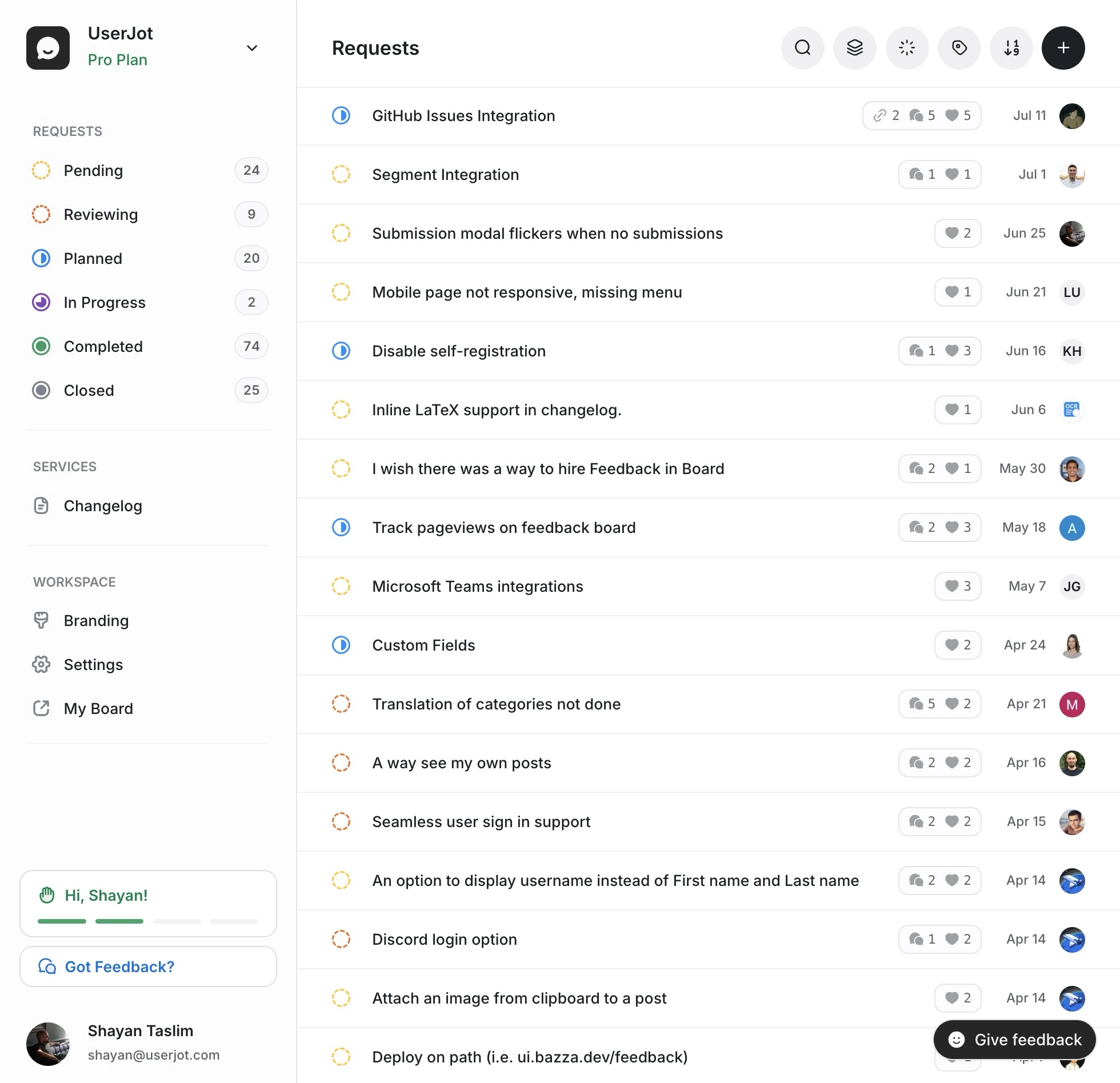
Key Features
- Unlimited users on all plans (vs ProductBoard’s per-maker model)
- AI-powered categorization and duplicate detection
- Public roadmaps with timeline views
- Automated changelog generation
- In-app feedback widget
- JWT-based SSO included
- Guest feedback without accounts
- Weekly digest emails
- One-click migration from ProductBoard
- Custom domains and white labeling
Pros
- 99% cost savings: $29/month vs $3,500+/month
- 5-minute setup: No consultants or training needed
- All features included: No artificial tier restrictions
- Modern interface: Clean, intuitive design
- Unlimited tracked users: No per-seat penalties
- Responsive support: Real humans, quick responses
- Public-first approach: Built for transparency
Cons
- Less strategic planning: No RICE scoring or complex frameworks
- Simpler analytics: Basic metrics vs ProductBoard’s depth
Real-World Impact: Teams switching from ProductBoard often tell us they’re getting more engagement with UserJot’s simpler interface. When tools are easier to use, more people use them. When feedback is easier to give, you get more of it.
Pricing: Free forever plan with core features, $29/month Starter (custom domain, branding), $59/month Professional (SSO, unlimited boards, advanced features).
Best for: Growing SaaS companies that need professional product management tools without enterprise complexity or pricing. Perfect for teams from 1-100 people. Learn more on our ProductBoard alternative page.
Stop guessing what to build. Let your users vote.
Try UserJot free2. Canny: The Modern Standard
Canny emerged as the modern alternative to legacy tools like ProductBoard, offering a cleaner interface and more transparent approach to product feedback.
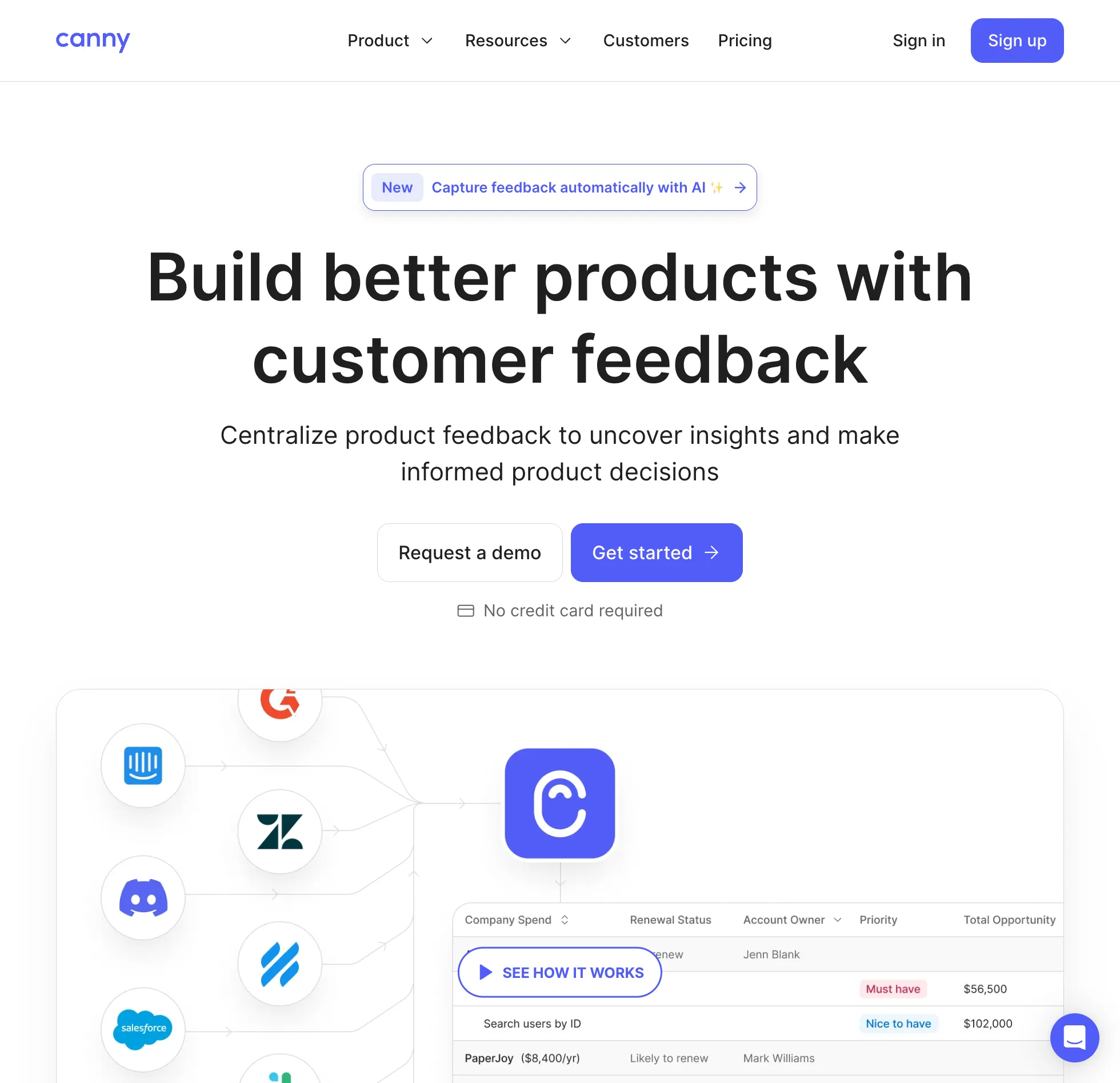
Key Features
- Public and private feedback boards
- Voting and commenting system
- Roadmap with multiple views
- Changelog with announcements
- AI Autopilot for organization
- Jira, Linear, Slack integrations
- Custom domains
- API access
- Moderation tools
- Basic analytics
Pros
- Simpler than ProductBoard: Days to learn vs weeks
- Better UX: Clean, modern interface
- Public by default: Built for community engagement
- Good integrations: Modern tool connections
- Proven track record: Thousands of customers
- Regular updates: Active development
Cons
- Tracked user pricing: Costs escalate with growth
- Feature limitations: Less sophisticated than ProductBoard
- No advanced frameworks: Missing RICE, custom scoring
- Basic analytics: Limited insights vs enterprise tools
Watch the User Counting: Like ProductBoard’s per-maker model, Canny’s tracked user pricing can surprise you. Anyone who votes, comments, or has feedback submitted counts. The AI Autopilot automatically adds users, potentially pushing you into higher tiers.
Pricing: Free up to 25 tracked users, $79/month Starter, $359/month Growth, custom Enterprise.
Best for: Product teams wanting a modern ProductBoard alternative without the enterprise features or pricing complexity.
3. Aha!: Even More Enterprise
If ProductBoard isn’t enterprise enough, Aha! takes product management to another level. It’s the full strategic planning suite with everything from idea management to detailed capacity planning.
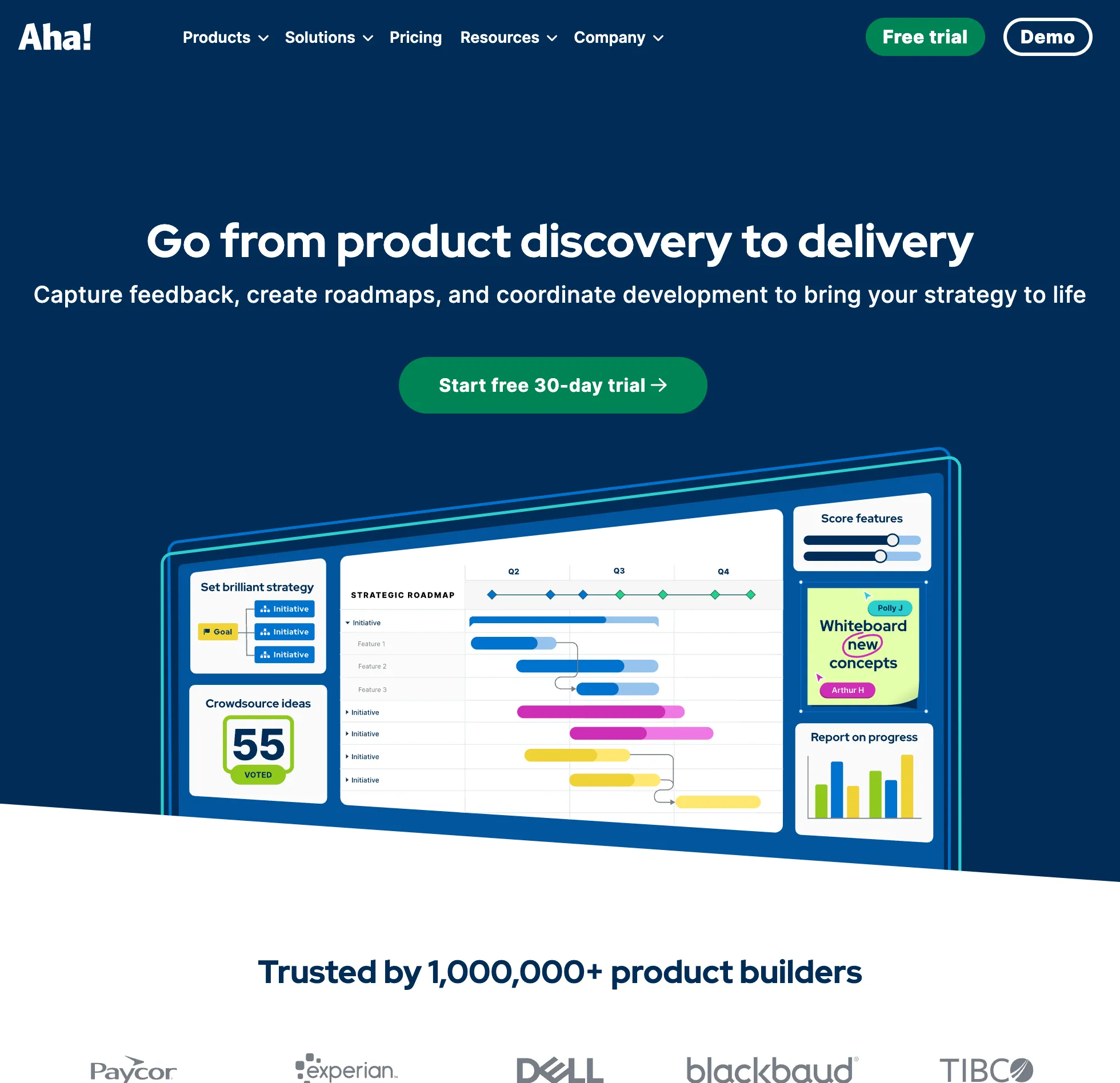
Key Features
- Strategic planning (goals, initiatives, OKRs)
- Visual roadmapping with multiple views
- Capacity and resource planning
- Custom workflow builder
- Ideas portal for feedback
- Competitor tracking
- Executive presentation mode
- Advanced analytics and reporting
- Extensive customization
- 100+ integrations
Pros
- More comprehensive: Everything ProductBoard has plus more
- Strategic tools: Built-in OKR and goal tracking
- Visual flexibility: Multiple roadmap presentations
- Deep customization: Build any workflow
- Strong support: Dedicated success managers
Cons
- Complex interface: Feels like 2010 enterprise software
- Steep learning curve: Often need consultants
- Feature overload: Too many options overwhelm
- High cost: $35,000+ annually for teams
- Slow performance: Can feel sluggish
Feature Overload Warning: Many teams find Aha! overwhelming. There are so many features, views, and options that simple tasks become complex. If ProductBoard already feels complicated, Aha! will feel impossible.
Pricing: $59/user/month Roadmaps, $99/user/month Ideas, $149/user/month Ideas Advanced.
Best for: Large product organizations needing comprehensive strategic planning tools and willing to invest significant time in learning complex software.
4. ProdPad: Opinionated Product Management
ProdPad takes a different approach, focusing on product management workflows and enforcing best practices whether you want them or not.

Key Features
- Lean roadmapping (now/next/later)
- Idea management and validation
- Customer feedback loops
- AI-powered spec writing
- Impact mapping
- Modular pricing structure
- Integration with dev tools
- Product decision history
- Team collaboration
- Custom fields
Pros
- Best practices built-in: Guides good PM habits
- Strong idea management: Better than ProductBoard
- AI assistance: Helps write specs and stories
- Good documentation: Forces clarity
- Modular approach: Buy only what you need
Cons
- Inflexible philosophy: No dates on roadmaps
- Constraining: Less freedom than ProductBoard
- Complex pricing: Per module per editor
- Limited customization: Their way or highway
- Can get expensive: $72/editor/month for full features
The Opinionated Approach: ProdPad believes in specific methodologies and builds them into the software. No dates on roadmaps. Ideas must be validated. Everything connects to outcomes. Some teams love the structure; others find it limiting.
Pricing: $24/editor/month per module. Most teams need 2-3 modules, making it $48-72/editor/month.
Best for: Product teams that embrace lean methodologies and want software that enforces best practices rather than maximum flexibility.
5. Airfocus: Modular and Strategic
Airfocus positions itself as the modular product management platform, focusing on prioritization and strategy over feedback collection.
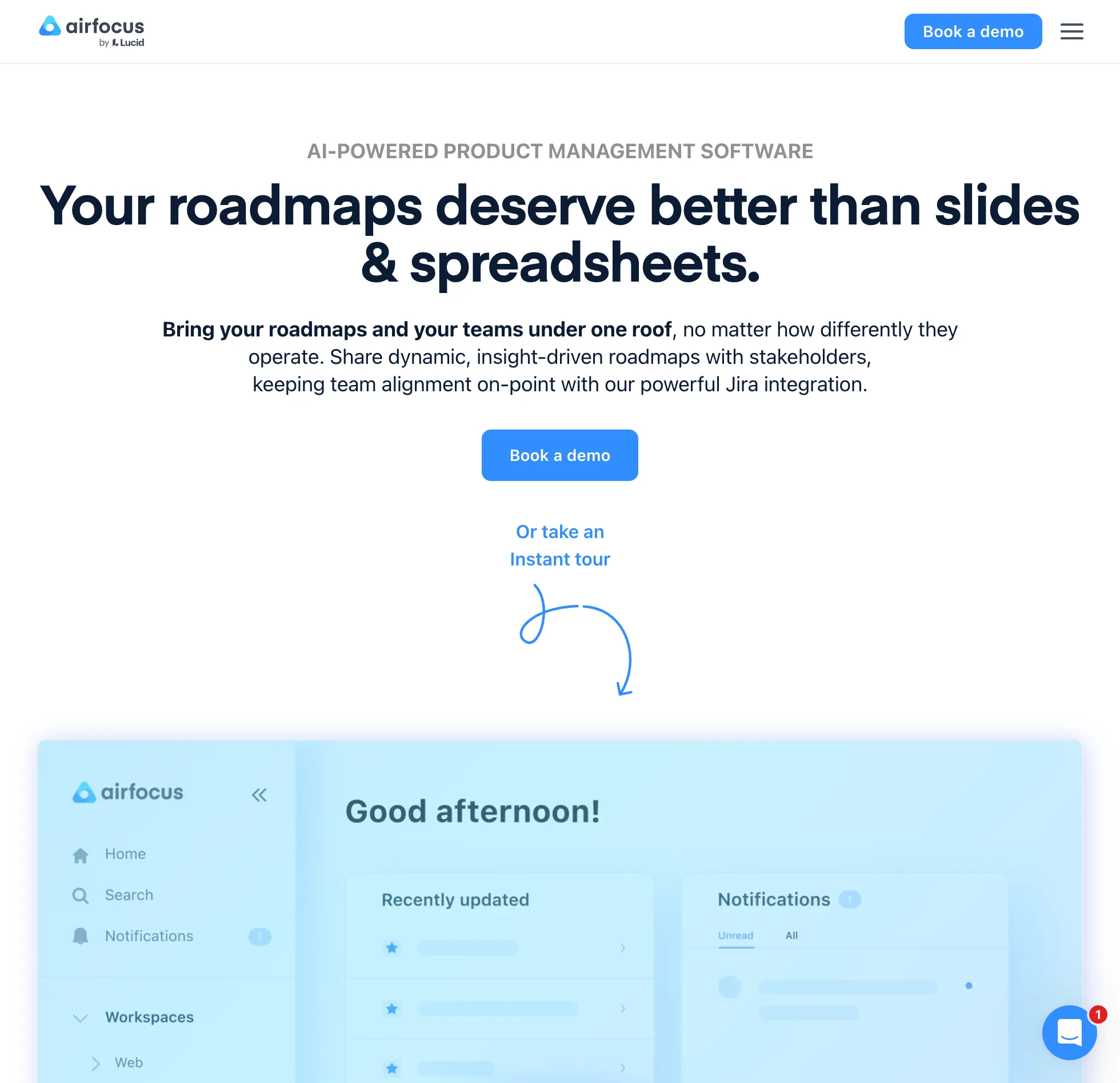
Key Features
- Priority scoring (RICE, custom frameworks)
- Visual prioritization matrix
- Flexible roadmaps (timeline, Kanban, Gantt)
- OKR management
- Custom fields and views
- App building capabilities
- Integration marketplace
- Collaborative workspaces
- API access
- Portfolio management
Pros
- Excellent prioritization: Best-in-class scoring tools
- Modular architecture: Add features as needed
- Visual approach: Great charts and matrices
- Flexible: More customizable than most
- Modern interface: Clean and intuitive
Cons
- Weak feedback tools: Strategy over insights
- Costs add up: Modules and add-ons expensive
- Less comprehensive: Missing ProductBoard features
- Limited free options: No real free plan
- SSO only on Enterprise: Common feature gated
Less Feedback, More Strategy: Where ProductBoard started with feedback and added strategy, Airfocus started with strategy and added feedback. The feedback features feel secondary.
Pricing: $19/user/month Starter, $69/user/month Pro, custom Enterprise.
Best for: Product teams focused on strategic prioritization who want modular software they can customize to their workflow.
6. ProductLift: The Indie Alternative
ProductLift represents the complete opposite of ProductBoard’s enterprise approach. Run by a solo founder, it focuses on simplicity and personal service.

Key Features
- Unlimited users on all plans
- Feedback boards and voting
- Public roadmap
- Changelog with notifications
- White labeling (even on starter)
- Custom domains
- Basic integrations
- Email notifications
- GDPR compliant
- Personal support
Pros
- Incredibly affordable: $9/month starting
- Personal touch: Direct founder support
- No complexity: Learn in 10 minutes
- Unlimited users: Even on cheapest plan
- Quick setup: Running in minutes
- Transparent development: See what’s being built
Cons
- Basic features only: No advanced PM tools
- Limited integrations: Essential connections only
- Huge price jump: $14 to $499 with nothing between
- Solo founder risk: What if they stop?
- No advanced analytics: Very basic metrics
Simplicity Has Limits: ProductLift intentionally lacks ProductBoard’s advanced features. No complex prioritization frameworks. No strategic planning tools. Basic analytics only.
Pricing: $9/month Startup, $14/month Growth, $499/month Scale-up.
Best for: Small teams and startups who value simplicity and personal service over extensive features.
7. Nolt: Radical Simplicity
Nolt strips product feedback down to its essence. Where ProductBoard adds layers of features, Nolt removes everything non-essential.
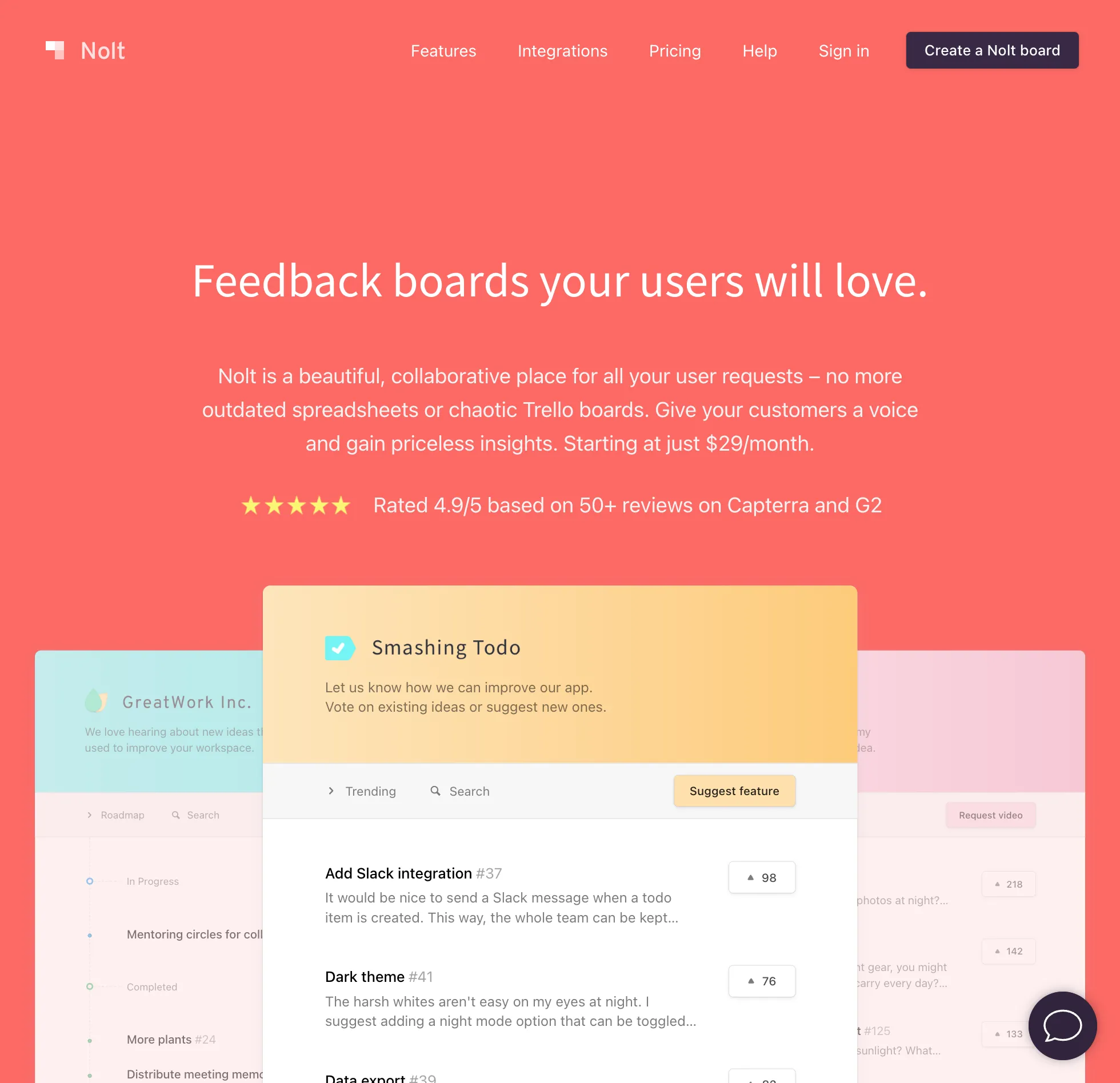
Key Features
- Simple feedback boards
- Voting and commenting
- Basic roadmap
- Email notifications
- Guest voting
- Moderation tools
- Custom domains
- Slack, Jira, Linear integrations
- CSV export
- Mobile responsive
Pros
- Dead simple: No training needed
- Fast setup: Live in under an hour
- Clean interface: Focus on content
- Fair pricing: No per-user charges
- Reliable: Does basics perfectly
- Good support: Responsive team
Cons
- Very limited features: Missing most PM tools
- No free plan: Must pay from start
- Basic roadmaps: Minimal functionality
- No analytics: Almost no insights
- Limited customization: Very basic branding
What You Give Up: Nolt lacks virtually everything that makes ProductBoard complex. No prioritization frameworks. No strategic planning. No advanced analytics. No custom workflows.
Pricing: $29/month Essential, $69/month Pro. No free plan.
Best for: Teams escaping ProductBoard’s complexity who only need basic feedback collection and organization.
8. Monday.com: Build Your Own
Monday.com isn’t built for product management specifically, but its flexibility lets you create custom product workflows.

Key Features
- Customizable boards and workflows
- Multiple views (Gantt, Kanban, timeline)
- Form builder for feedback
- Automation engine
- Custom fields and formulas
- Dashboard builder
- 200+ integrations
- Mobile apps
- Guest access
- API and webhooks
Pros
- Total flexibility: Build any workflow
- Visual approach: Great for visual thinkers
- Strong automation: Reduce manual work
- Extensive integrations: Connects to everything
- One tool for everything: Consolidate platforms
- Good mobile apps: Full functionality
Cons
- Not product-specific: Missing PM features
- Requires setup: Build from scratch
- No voting mechanism: Hard to replicate
- Limited public options: Workarounds needed
- Can get complex: Easy to over-engineer
Building Your Own ProductBoard: You’re essentially creating your own product management system. More work upfront than ProductBoard’s ready-made system, but you get exactly what you need.
Pricing: $9/seat/month Basic, $19/seat/month Pro, $29/seat/month Enterprise.
Best for: Teams already using Monday.com who want to consolidate tools, or those preferring custom workflows over specialized software.
9. Linear: Engineering-First Product Management
Linear started as an issue tracker but evolved into a full product development platform. It’s what happens when developers build product management software.
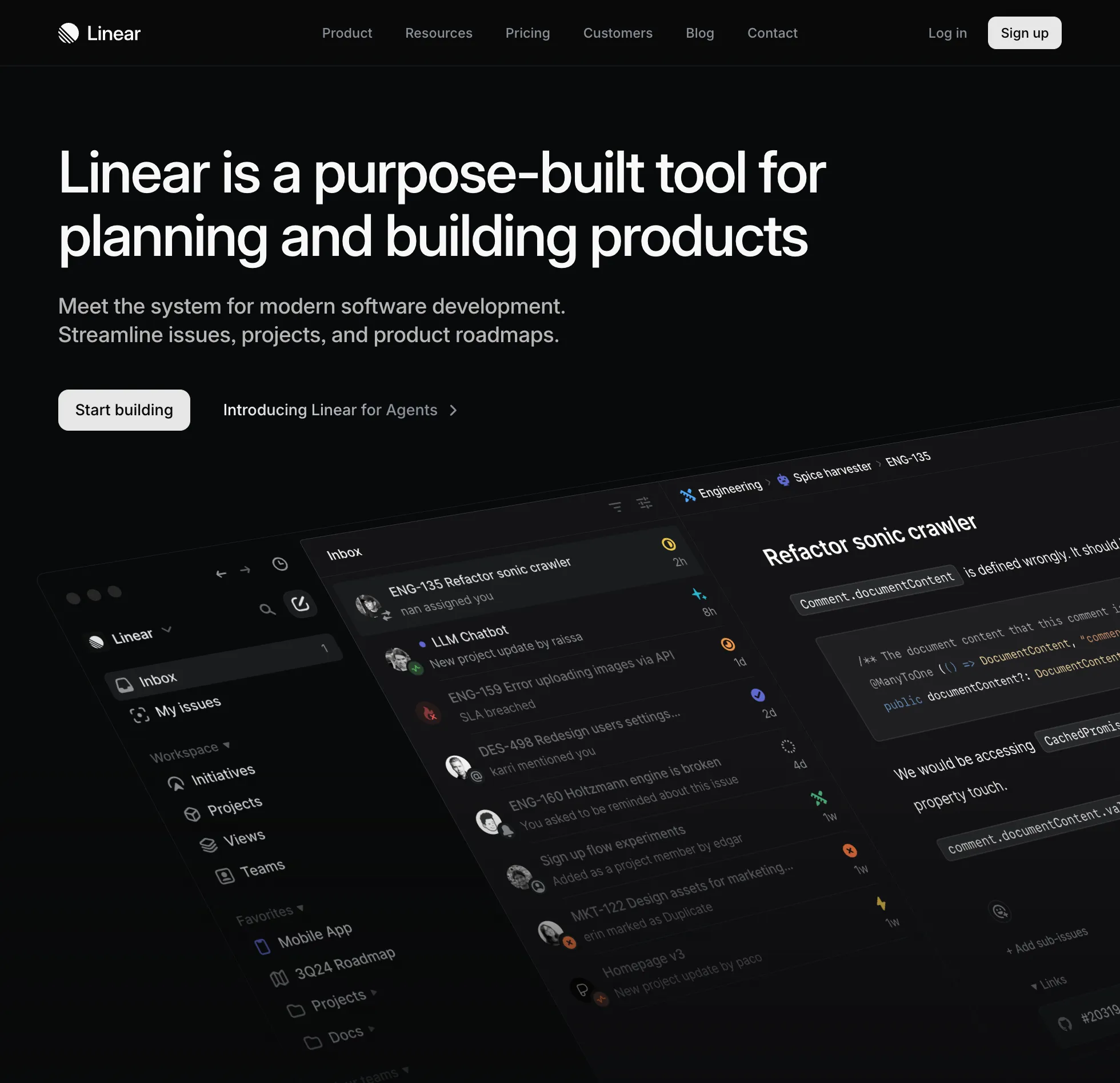
Key Features
- Lightning-fast interface
- Keyboard-driven navigation
- Git-like branching for roadmaps
- Automatic sprint planning
- GitHub/GitLab sync
- Real-time collaboration
- API-first architecture
- Custom workflows
- Basic feedback collection
- Project tracking
Pros
- Incredibly fast: Best performance in class
- Developer-friendly: Engineers love it
- Clean design: Minimal but powerful
- Good execution tools: Great for building
- Strong API: Automate everything
- Opinionated workflow: Guides best practices
Cons
- Limited feedback tools: Basic collection only
- No voting: Missing key PM feature
- Engineering-focused: Less strategic planning
- Inflexible: Strong opinions on process
- Basic roadmaps: Simple compared to ProductBoard
Different Than ProductBoard: Linear focuses on execution and velocity. It’s exceptional at managing what you’re building but less sophisticated at deciding what to build.
Pricing: $8/user/month Standard, $14/user/month Pro, custom Enterprise.
Best for: Technical product teams who prioritize execution speed over strategic planning and work closely with engineering.
How to Choose the Right ProductBoard Alternative
By Budget: Under $30/month go with UserJot (free plan), ProductLift ($9), or Nolt ($29). For $30-100/month, Canny ($79) is the modern standard. Teams needing advanced features should consider ProdPad or Airfocus at $100-500/month. Only consider Aha! or staying with ProductBoard if you have true enterprise budgets.
By Company Stage: Pre-PMF teams should use UserJot Free or ProductLift. Early growth (1-20 people) fits UserJot or Canny, or Linear if engineering-led. Scale-ups (20-100) need UserJot Professional or Canny Business. Enterprises (100+) might justify Aha! or ProductBoard.
By Primary Need: For customer feedback choose UserJot, Canny, or Nolt. Strategic planning requires Aha!, Airfocus, or ProdPad. Engineering teams prefer Linear or Monday.com. If simplicity matters most, go with ProductLift or Nolt.
Migration Difficulty: UserJot provides assistance (easiest). Canny and Aha! have import tools (moderate). ProdPad and Airfocus require some manual work (harder). Monday.com and Linear mean rebuilding from scratch (hardest).
Making the Right Choice
If ProductBoard is too expensive: UserJot gives you essential features at 1% of the cost. Canny and Nolt offer middle-ground options under $100/month.
If ProductBoard is too complex: Nolt and ProductLift strip away complexity. UserJot balances features with simplicity.
If you need more than ProductBoard: Aha! adds strategic planning tools (at a price). Airfocus offers modular expansion.
If you want flexibility: Monday.com lets you build your own system. Linear offers a different but opinionated approach.
For most teams: UserJot hits the sweet spot with professional features, fair pricing, and an interface people actually enjoy using. It’s what ProductBoard could have been if they hadn’t abandoned the 99% to chase enterprise deals.
The product management tool space has exploded with options. You no longer need to accept enterprise pricing and complexity for professional features. Pick based on what you actually need, not what vendors think enterprises want.
Stop guessing what to build. Let your users vote.
Try UserJot freeFrequently Asked Questions
Why is ProductBoard so expensive compared to alternatives?
ProductBoard targets Fortune 500 companies exclusively now, with pricing to match. At $70,000-$100,000/year for most teams, they’ve deliberately priced out smaller companies. Their per-maker model means costs scale with team size, and essential features like SSO require Enterprise plans. Alternatives like UserJot offer similar core features at 1% of the cost by focusing on growing teams instead of enterprises.
Can I migrate my data from ProductBoard to these alternatives?
Yes, but complexity varies. UserJot offers hands-on migration assistance to make switching smooth. Canny and Aha! provide import tools and documentation. ProdPad has a formal migration process. Linear and Monday.com require more manual setup since they’re different types of tools. Always export your ProductBoard data first - at those prices, you definitely own it.
Which alternative is most similar to ProductBoard in features?
Aha! offers the most comparable feature set but actually adds even more complexity and costs $35,000+/year. Canny provides similar core functionality with a cleaner, more modern interface. UserJot covers the features most teams actually use daily (feedback, roadmaps, changelogs) without the enterprise bloat. The “most similar” depends on which ProductBoard features you actively use vs just pay for.
Do these alternatives offer the same security and compliance as ProductBoard?
Enterprise-focused tools like Aha! match or exceed ProductBoard’s security certifications. UserJot and Canny offer SOC 2 compliance, GDPR compliance, and enterprise security features that satisfy most requirements. Smaller tools like Nolt and ProductLift have basic security but may lack formal certifications. Linear and Monday.com have strong security as they serve enterprise clients. Assess based on your actual requirements, not just what ProductBoard sells you.
What features will I lose switching from ProductBoard?
You’ll likely lose advanced prioritization frameworks (RICE scoring, custom formulas), complex multi-level custom workflows, some enterprise integrations, and sophisticated product analytics. However, most teams report they weren’t actually using these features. Core functionality like feedback collection, roadmap management, and team collaboration is available in all alternatives, often with better user experience.
Is it worth paying for ProductBoard’s advanced features?
Only if you actively use them and can measure their ROI. Studies show most teams use less than 20% of ProductBoard’s features but pay for 100%. If you need sophisticated product analytics, complex prioritization frameworks, and enterprise governance, it might justify the cost. For 95% of teams, simpler alternatives deliver better value by focusing on features you’ll actually use.
Which tool has the best roadmapping features?
Aha! has the most comprehensive roadmapping with multiple timeline views and presentation modes. Airfocus offers excellent visual prioritization within roadmaps. UserJot and Canny provide clean, shareable public roadmaps perfect for transparency. ProductBoard’s roadmaps are good but primarily built for internal use. Linear has basic roadmaps but excels at execution tracking. Choose based on whether you need internal planning or public sharing.
Should I build my own solution with Monday.com or Linear?
Only if you enjoy building and maintaining custom workflows or already use these tools extensively. Purpose-built tools like UserJot or Canny deliver faster time-to-value with product-specific features out of the box. Monday.com makes sense if you want to consolidate multiple tools into one platform. Linear works well for engineering-driven teams who prioritize execution over strategy. Most teams are better served by specialized product management tools.
How long does it take to switch from ProductBoard?
The switch itself can be done in a day or weekend. UserJot’s migration takes about 2-4 hours with assistance. Canny setup takes a few hours. The real time investment is change management - getting your team comfortable with the new tool. Most teams report being fully productive within a week, much faster than their original ProductBoard onboarding which often took weeks or months.
What do I do about ProductBoard’s automatic renewal?
Check your contract immediately. ProductBoard typically requires 60-90 days notice before renewal to avoid automatic renewal with the 5% price increase. Export all your data now while you have access. Start trialing alternatives immediately so you’re ready to switch before the renewal deadline. Many alternatives offer extended trials if you’re actively migrating from ProductBoard - just ask their sales teams.